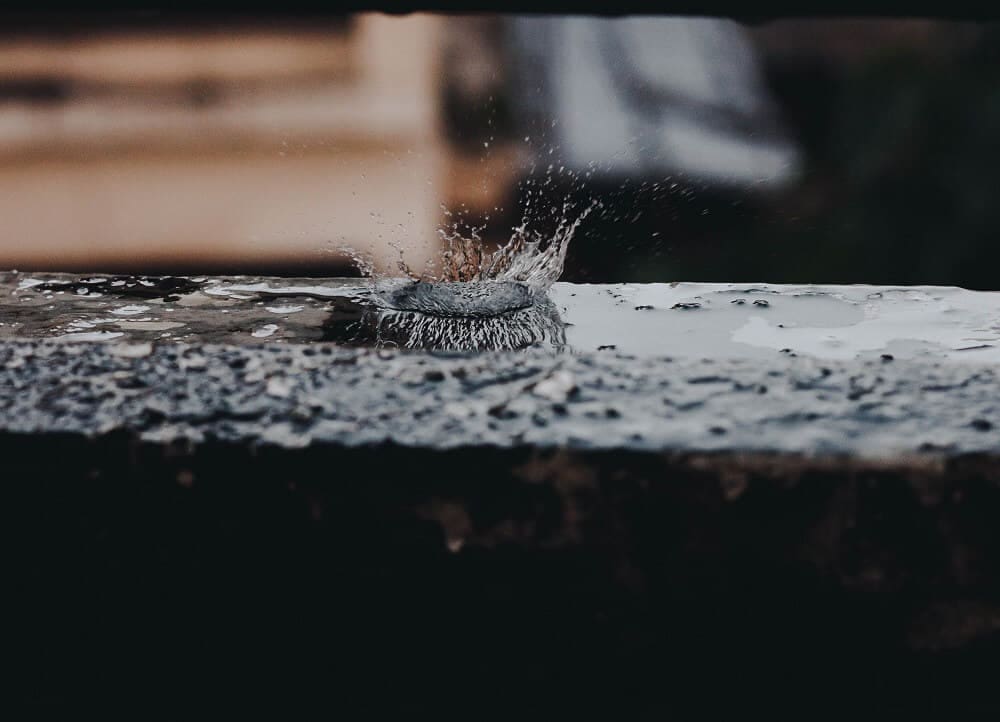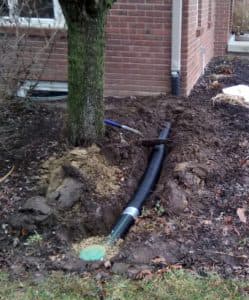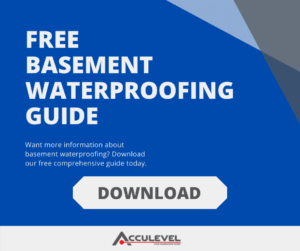How to Waterproof a Basement on the Outside

Originally posted 3/25/19, revised 8/16/21
We understand that water intrusion can be a frustrating struggle for homeowners. You have to move anything that’s in the way, mop up the puddles, clean the floor/wall, and then dry your basement…only to do it all again, the next time it rains!
There is no substitute for a high quality interior water drainage system. And if you have water getting into your basement, that is definitely what you need. But that doesn’t mean you’re completely helpless- there are some steps you can take to reduce the water intrusion in your home.
A family-owned and operated company, Acculevel has been waterproofing homes throughout Indiana and the surrounding areas since 1996. We offer a variety of water drainage types, depending on your needs and the construction of your foundation. These waterproofing systems are dependable, manage the water that comes in promptly and efficiently, and are warrantied for the life of your home.
Acculevel’s goal is five star customer service, from start to finish. So we’re going to provide you with 3 ways you can reduce the amount of water that gets into your home, before you call us for help.
Acculevel recommends interior waterproofing over exterior waterproofing methods: interior water drainage is less disruptive, less expensive, and installed much more quickly.
Gutters & Downspouts
Let’s start with the task that requires a ladder, shall we? You’ll need to climb up and inspect your home’s guttering. Clean out any pine needles, leaves, or other debris that could be blocking the water flow. Re-attach sections that are loose, or replace damaged pieces.
The main purpose of gutters is to collect and direct rainwater. Guttering keeps water from pouring off the edge of the roof and draining next to your home’s foundation. The same thing is true for downspouts; these are the pieces attached to the end of the guttering, where the rainwater empties.
Your downspouts should extend out and away from your home; we recommend a minimum distance of 10 feet. Water close to your foundation is going to cause stress to the foundation, through hydrostatic pressure and water leaks.
Do you need downspout extensions? This is a possible DIY project, if you’re so inclined.
 This photo was taken by an Acculevel team member, while installing a downspout extension for a customer. (The extension was later buried under several inches of soil.)
This photo was taken by an Acculevel team member, while installing a downspout extension for a customer. (The extension was later buried under several inches of soil.)
Landscaping & Plants
The next thing to check over is the landscaping around your foundation. If you have flower beds or plantings close to your home, are they well-drained? Check any features you have- things like bird baths, large rocks, anything that could be collecting water and overflowing towards the house.
You should also evaluate any borders that you’ve added, to make sure they don’t trap water close to the foundation. Timbers that look like railroad ties have a nice rustic look which is popular; unfortunately damp wood is a good way to attract insects like termites. While termites can’t hurt a concrete foundation, they can harm the wooden components of your flooring structure (beams, joists, etc).
You should also try to avoid planting large trees or shrubs close to your home. This is partially due to the amount of water these plants require. But you also have to remember that roots digging in the dirt can also dig into your foundation.
Slope
Before you make any major changes to your landscaping, you should also check the slope of your yard. Stand in your driveway, or on the sidewalk- somewhere you’ll be safe, but can still see the overall shape of your property. The ground around your home should not be flat; it should have a gentle slope down and away from the house. This helps encourage natural water drainage.
If the slope has been disrupted or compromised, you’ll need to restore it. This could require bringing in additional soil, moving plants, etc. A good landscaping company can do this for you, as well as help you evaluate the plants and placement around your home.
The Next Step
Following these three recommendations should help reduce or slow the amount of water that intrudes into your basement, but they won’t stop it from occurring. You probably have questions about basement waterproofing: what causes water leaks, how drainage is installed, which drainage type is best for your home, the costs involved. All of these questions, and more!, are addressed in our comprehensive basement waterproofing guide.
Want to Talk with an Expert?
If you live in Indiana or the surrounding areas, you should contact Acculevel at 866-669-3349. (Or you can fill out this contact form.) We will schedule a free in-home appointment for you with one of our experienced and helpful project advisors.
Your project advisor will meet with you at your home; they will be on-time, address your concerns, evaluate your home, and review with you a detailed plan to restore your home’s health and your peace of mind. This plan for a whole-home solution will be provided in writing, with pricing, and is valid for 30 days.
If you do not live within our service area, you should find another reputable and reliable waterproofing contractor who is an accredited member of the Better Business Bureau. Check the company’s reviews, and if possible, get referrals or recommendations from friends, neighbors, or family members. We encourage you to also use Questions to Ask a Contractor, a detailed guide that we designed to help homeowners carefully vet contractors before making a purchase or commitment.

